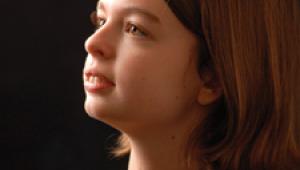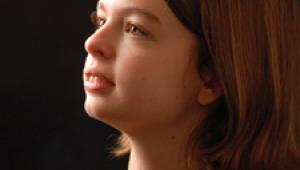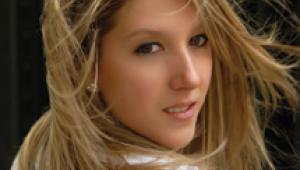Real Portraits
A True Reflection Of The Subject
I take portraits of people every day. They pay me (hopefully) to create an
image that says something about them. Perhaps it's a family who loves
the ocean; we'll take a beach portrait. Maybe it's a mom who wants
me to closely match a portrait done of her when she was 2. Or it could be a
high school senior who wants to show how he's making the transition from
teen-ager to adult.
All of these are very valid reasons to have a portrait done, and all attempt
to give the viewer a glimpse into who that person really is. And if I'm
successful, I'll be happy that I've at least captured a tiny bit
of the subject's personality and they'll be happy with my usually
flattering portrait. That's what I get paid to do, and as jobs go, it's
a very satisfying accomplishment to create an image that pleases both my subject
and me. Heck, if I didn't have to worry about sales, marketing, taxes,
and all the other stuff that comes with running a photo studio, it'd be
darn near perfect!
But there are times when I create what I call a "real portrait."
It's a portrait that allows us to really see what the subject is all about--no
makeup, fancy clothes, artificial propping, or situation that does not ring
100 percent true with the subject.
I'll be the first to admit that of all the portraits I take of people,
probably less than 2 percent would qualify as "real portraits."
And when I "get one," it's a great feeling. So for this article,
rather than try to pretend I'm Thomas Wolfe and try to explain all these
"deep thoughts," I'll show you some examples so you can see
what I'm talking about. I've asked my fellow photographers Don Chick
and Chris Beltrami to contribute because I immediately saw a "real portrait"
when I viewed their images that you see here. They were kind enough to include
some of the thought processes that went into making these terrific images. A
great self-assignment would be to create a "real portrait" of someone
close to you. It's a little more complicated than just taking Sarah with
her surfboard. Give it a try and see what you can create.
By the way, don't forget to sign up for my free e-mail newsletter at:
steve@stevebedell.com.
"Monsters In My Attic"
Ande is an artist. However, as you can see from the photograph, his is not typical
art. Therefore my lighting approach on his face and body was dramatic, but not
typical. Since there was not enough light in his attic to use existing light,
I utilized a four-light power pack. The first light was in front of Ande, positioned
on the floor. This put an unnatural light pattern (from beneath) on the front
of him and his face. The second light was positioned to camera left and behind
him. I like dramatic lighting and this added a rim light to his face and arms
as well as providing backlighting for the cigarette smoke. The third light was
again positioned to camera left and this time behind Ande. This light illuminated
his easel and art supplies. The fourth and final light was also to camera left
and was used to light up his art hanging on the back wall.
 |
|
|
Once finished with the retouching in Photoshop, I duplicated the layer and
opened the Unsharp Masking dialog box. I adjusted the sliders for both the "amount
percentage" and the "radius pixels" way to the right to create
an over-sharpened image. I then adjusted the opacity of the sharpened layer
to blend with the unsharpened layer beneath to get the "illustration"
look.
The final image is one that incorporates a very interesting subject matter with
dramatic lighting, posing, and a little bit of Photoshop magic.
--Don Chick
"Lena"
I was on my way to a meeting when I passed this house where my late aunt and
uncle used to visit during our Saturday morning fishing trips when I was about
10 years old. I caught a glimpse of someone as I passed by. I thought, "Surely
that can't be Lena, she'd have to be in her late 80s by now."
I remember her as a very funny and bristly kind of gal. I thought about this
and after a couple of miles, I turned back.
 |
|
|
I drove into the driveway and shouted, "Lena!"
With one eye squinted, she shouted back, "Who the heck are you?"
I told her who I was and we sat and talked about 15 minutes, then I took this
photo. I didn't move a thing. I love the colors and the natural props
that tell the story of her life. The garden tools on the left are critical.
The watering can, the laundry basket, the green Astro turf floor, the unposed
posture, and unadjusted clothing are all elements that need to be in this photo
for "the truth." I left the car in the bottom right corner because
it reminds me of the day and how things looked when I first saw her.
The light comes in under the porch from right to left and the overhang "subtracts"
the overhead light, giving us a wonderful, directional light.
This photo was taken with a Canon EOS 10D camera, ISO 200, auto everything.
A week later I brought my wife Pat to see Lena and we talked and laughed for
an hour!
--Chris Beltrami
 |
|
|
This is a very special photo to me; it is my wife's mother. She has been confined to St. Anne Healthcare, a Catholic-based elderly care facility. I went to see her with my wife, daughter, and son-in-law. I brought my Fuji S2 with me to take just a few candid photos of her with family. As she was sitting in her wheelchair talking I noticed the interesting composition of the bishops' photos over her head. I also noticed the wonderful light coming in from the windows. Sensing a "real" portrait opportunity, I moved a chair slightly, jammed myself against a wall, put my zoom lens as wide as it would go, and took a few photos.
She is a deeply religious woman and the expression she has in this image is
one she wears often--one who, at 93 years old, has seen what she's
needed to and is ready to move on to another life. It is unposed and I did nothing
to elicit expression.
The final image was converted to black and white in Photoshop and cropped slightly.
--Steve Bedell
- Log in or register to post comments

















































